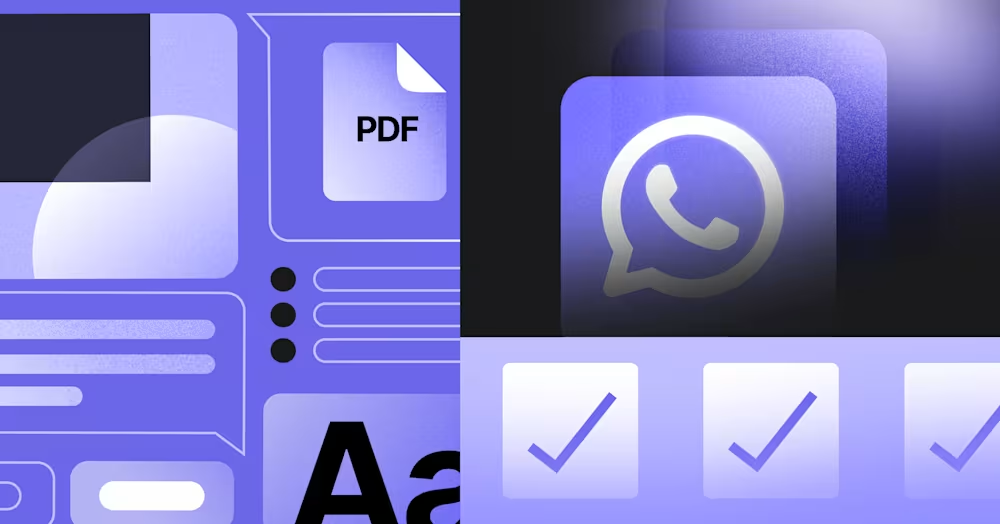
เทมเพลตข้อความ WhatsApp: คู่มือการใช้งานพร้อมตัวอย่าง 13 รายการ
ธุรกิจไม่สามารถส่งข้อความ WhatsApp ได้หลังจาก 24 ชั่วโมง เว้นแต่จะใช้เทมเพลตข้อความ WhatsApp เรียนรู้วิธีการจัดรูปแบบและส่งข้อความเทมเพลตพร้อมตัวอย่าง

หนึ่งในข้อได้เปรียบที่ใหญ่ที่สุดของการใช้ WhatsApp เป็นช่องทางการสื่อสารกับลูกค้าคือความสามารถในการทำงานอัตโนมัติงานที่ทำซ้ำหรือใช้เวลานานผ่านการทำงานอัตโนมัติของ WhatsApp. แต่สำหรับผู้เริ่มต้น ความคิดนี้อาจฟังดูน่ากลัวเล็กน้อย. ในคู่มือนี้ เราจะอธิบายถึงประโยชน์ของการทำงานอัตโนมัติของ WhatsApp Business ตัวเลือกการทำงานอัตโนมัติสำหรับขนาดธุรกิจที่แตกต่างกันและวิธีสร้างบอทอัตโนมัติของ WhatsApp ของคุณเอง.
พูดง่ายๆ การทำงานอัตโนมัติของ WhatsApp คือการทำให้การสนทนาเป็นอัตโนมัติบน WhatsApp Business App หรือ WhatsApp Business API. ด้วยการทำงานอัตโนมัตินี้ ธุรกิจสามารถประหยัดเวลาและทรัพยากร ปรับปรุงเวลาในการตอบกลับ และเพิ่มความพึงพอใจของลูกค้า.
ธุรกิจขนาดเล็กและขนาดไมโครสามารถตั้งค่าการทำงานอัตโนมัติพื้นฐานใน WhatsApp Business App จากโทรศัพท์หรือเดสก์ท็อป. ซึ่งรวมถึงข้อความต้อนรับและข้อความไม่อยู่เป็นต้น.
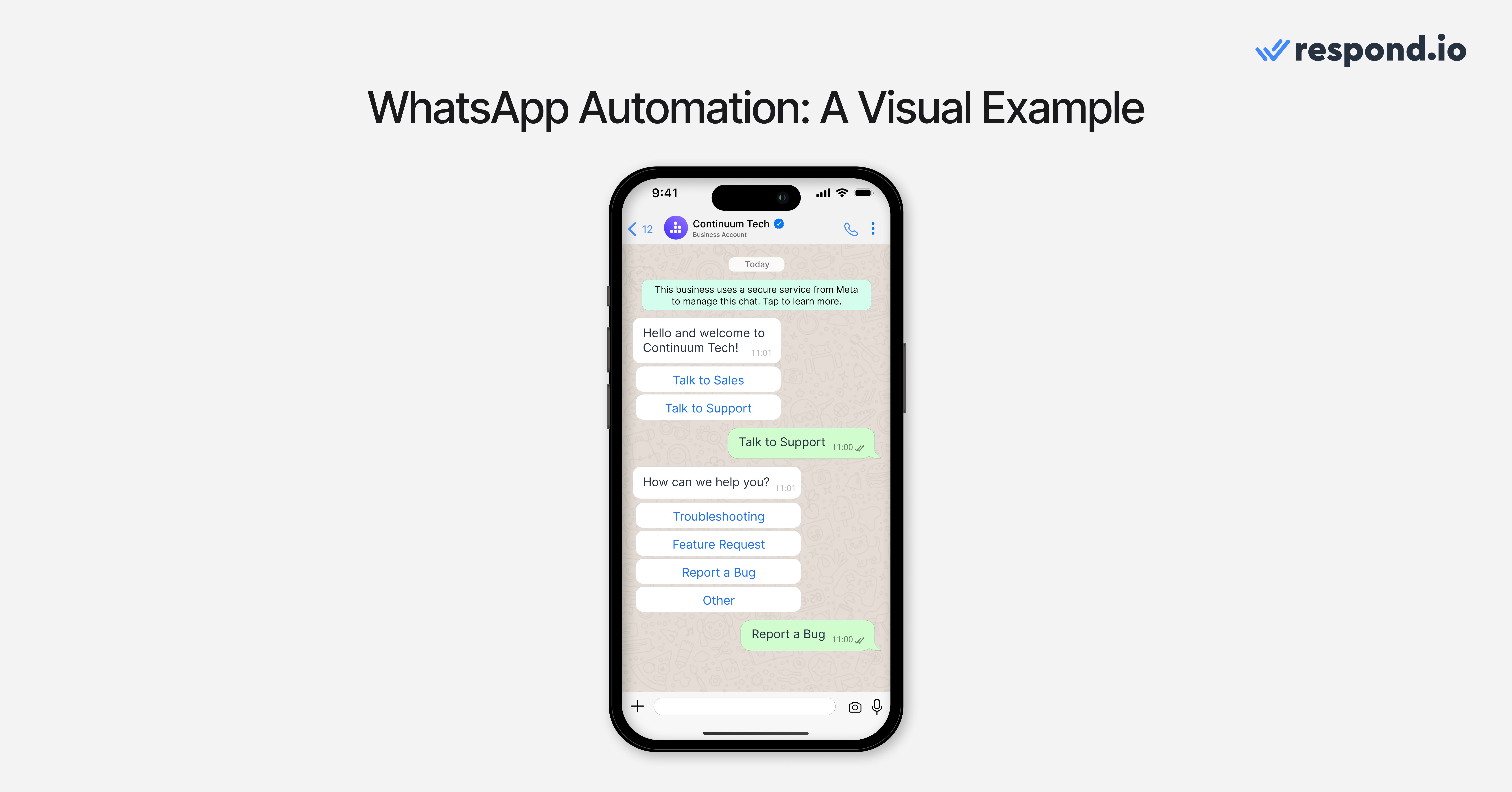
สำหรับบริษัทขนาดกลางและขนาดใหญ่ที่ต้องการทำให้ธุรกิจที่ทำซ้ำหรือซับซ้อน เช่น การกำหนดเส้นทางการแชท และ การกำหนดตัวแทน นั้นจะยุ่งยากขึ้น. ในอดีต สิ่งนี้ไม่สามารถทำได้เนื่องจากข้อจำกัดของแอป. แต่ในปี 2018 WhatsApp API ได้เปิดตัว ซึ่งทำให้ปัญหานี้สิ้นสุดลง.
เนื่องจากความนิยมที่เพิ่มขึ้นของการขายผ่านการสนทนาและการสนับสนุน บริษัทต่างๆ มากขึ้นกำลังใช้การทำงานอัตโนมัติเพื่ออำนวยความสะดวกในการสื่อสารกับลูกค้าผ่าน WhatsApp. การทำงานอัตโนมัติของ WhatsApp กำลังเพิ่มขึ้น. แต่ทำไม? นี่คือข้อดีบางประการ.
ลดเวลาในการตอบกลับ - ข้อความตอบกลับอัตโนมัติของ WhatsApp เช่น ข้อความต้อนรับอัตโนมัติและข้อความไม่อยู่ช่วยปรับปรุงเวลาในการตอบกลับและมั่นใจได้ว่าลูกค้าได้รับข้อความแล้ว.
ลดภาระของตัวแทน - การทำงานอัตโนมัติลดภาระงานโดยอาจจัดการกับคำถามเฉพาะของลูกค้า เช่น การให้ตอบกลับอัตโนมัติต่อคำถามทั่วไปผ่านเมนู FAQ แบบโต้ตอบ.
เพิ่มอัตราแปลงการขาย - การทำงานอัตโนมัติของ WhatsApp ทำให้มั่นใจได้ว่าลูกค้าที่มีคุณสมบัติเฉพาะจะไปถึงตัวแทน ทำให้ประหยัดเวลาและอนุญาตให้ตัวแทนมุ่งเน้นไปที่โอกาสในการขายที่แท้จริง.
เพิ่มความพึงพอใจของลูกค้า - การทำงานอัตโนมัติช่วยกำหนดเส้นทางการสนทนาไปยังทีมที่ถูกต้องอย่างรวดเร็วขึ้นโดยการใช้แบบสอบถามก่อนการแชทเพื่อตรวจสอบข้อมูลของลูกค้าและกำหนดวัตถุประสงค์การสนทนา. การตอบกลับที่รวดเร็วนี้ช่วยปรับปรุงความพึงพอใจโดยรวมของลูกค้า.
เปลี่ยนการสนทนาให้กลายเป็นลูกค้าด้วย WhatsApp API อย่างเป็นทางการจาก respond.io. ✨
จัดการการโทรและแชท WhatsApp ในที่เดียว!
การทำงานอัตโนมัติของ WhatsApp มีวิธีการต่างๆ สำหรับธุรกิจในการปรับปรุงการดำเนินงานของพวกเขา. ตามที่เราจะกล่าวถึงในภายหลัง วิธีการส่วนใหญ่เหล่านี้ต้องใช้ WhatsApp API.
ก่อนอื่น สิ่งสำคัญคือต้องเข้าใจบทบาทของ APIs (Application Programming Interfaces) ในการทำงานอัตโนมัติของ WhatsApp. APIs ช่วยให้ธุรกิจสามารถรวบรวมซอฟต์แวร์หรือระบบเข้ากับแพลตฟอร์ม WhatsApp ทำให้นักพัฒนาสามารถสร้างโซลูชันแบบกำหนดเองสำหรับการทำงานอัตโนมัติในการติดต่อสื่อสาร WhatsApp ได้หลายวิธี.
มาลองสำรวจวิธีการบางประการที่ธุรกิจสามารถใช้การทำงานอัตโนมัติของ WhatsApp ได้.
ตัวแทนสนทนาอัตโนมัติเหล่านี้สามารถเข้าใจคำสั่งและคำถามของผู้ใช้ได้. โดยการใช้ประโยชน์จากอัลกอริธึมการเรียนรู้ของเครื่องและการประมวลผลภาษาธรรมชาติ (NLP) แชทบอทสามารถให้การตอบกลับที่กำหนดไว้ล่วงหน้าหรือสร้างขึ้นโดย AI ให้กับลูกค้าผ่าน WhatsApp ได้ในทันที.
โดยการใช้ข้อมูลลูกค้าและเครื่องมือติดต่อการขาย ธุรกิจสามารถส่งการกระจาย WhatsApp แบบกำหนดเอง มอบประสบการณ์ที่มีส่วนร่วมและปรับแต่งให้กับลูกค้า.
ธุรกิจสามารถตั้งค่าเวิร์กโฟลว์ใน WhatsApp เพื่อทำงานอัตโนมัติในงานและกระบวนการเฉพาะ. นี่มีการกำหนดกฎและการกระตุ้นที่เริ่มต้นการกระทำอัตโนมัติตามการมีส่วนร่วมของผู้ใช้หรือเงื่อนไขที่กำหนดไว้ล่วงหน้าอื่นๆ. ตัวอย่างเช่น สามารถสร้างเวิร์กโฟลว์อัตโนมัติเพื่อส่งการยืนยันการสั่งซื้อหรือการเตือนการนัดหมายให้กับลูกค้าโดยอัตโนมัติ.
ธุรกิจสามารถตั้งเวลา WhatsApp เพื่อส่งการอัปเดตและการแจ้งเตือนให้กับลูกค้าโดยอัตโนมัติ. ซึ่งรวมถึงการแจ้งเตือนที่สำคัญ การเตือนเหตุการณ์ และการอัปเดตสถานะการสั่งซื้อ เพื่อรับรองการสื่อสารแบบเรียลไทม์กับลูกค้าเกี่ยวกับข้อมูลสำคัญ.
ตอนนี้คุณทราบถึงประโยชน์และกรณีการใช้งานแล้ว เราจะมาดูวิธีการทำงานอัตโนมัติของ WhatsApp.
การทำงานอัตโนมัติของข้อความ WhatsApp ขึ้นอยู่กับโซลูชันที่คุณใช้ เนื่องจากขั้นตอนไม่เหมือนกันสำหรับ WhatsApp Business app และ WhatsApp Business API.
เมื่อกำลังตัดสินใจระหว่าง WhatsApp Business app และ WhatsApp API สำหรับการทำงานอัตโนมัติ ต้องเข้าใจความแตกต่างในฟังก์ชันและความสามารถของแต่ละแพลตฟอร์ม. ต่อไป เราจะให้การเปรียบเทียบที่ละเอียดเพื่อช่วยให้คุณตัดสินใจอย่างชาญฉลาด.
วิธีที่ง่ายที่สุดในการทำงานอัตโนมัติของ WhatsApp คือการใช้ WhatsApp Business app. แอปนี้ใช้งานได้ฟรีและเหมาะสำหรับธุรกิจขนาดเล็กที่มีผู้ใช้เพียงไม่กี่คนที่ต้องการเพียงการทำงานอัตโนมัติพื้นฐาน.
WhatsApp Business API มีตัวเลือกการทำงานอัตโนมัติขั้นสูงที่ธุรกิจขนาดกลางถึงขนาดใหญ่ต้องการ. ในการใช้มัน คุณจะต้องเลือกWhatsApp BSP และสมัครใช้งานแพลตฟอร์มการจัดการการสนทนา.
WhatsApp Business App | WhatsApp API |
|---|---|
การทำงานอัตโนมัติพื้นฐาน | การทำงานอัตโนมัติขั้นสูง |
ไม่มีการติดตามประสิทธิภาพการสนทนา | การติดตามประสิทธิภาพการสนทนา |
ไม่มีการรวมกับแชทบอท | การรวมกับแชทบอท |
ไม่มีเมนูแบบโต้ตอบ | เมนูแบบโต้ตอบที่ปรับแต่งได้ |
ไม่มีการทำงานอัตโนมัติ | สนับสนุนการทำงานอัตโนมัติ |
WhatsApp Business app มีการทำงานอัตโนมัติของการตอบกลับพื้นฐาน เหมาะสำหรับการตอบกลับอัตโนมัติที่เรียบง่าย. ในทางกลับกัน WhatsApp API เสนอการทำงานอัตโนมัติของการตอบกลับที่ซับซ้อน ช่วยให้การโต้ตอบอัตโนมัติมีความซับซ้อนและซับซ้อนมากขึ้น.
WhatsApp Business app ไม่มีฟีเจอร์สำหรับติดตามประสิทธิภาพการสนทนา ทำให้ยากที่จะวัดและวิเคราะห์ความมีประสิทธิภาพในการโต้ตอบ. WhatsApp API อย่างไรก็ตามรวมการติดตามประสิทธิภาพการสนทนา ที่อนุญาตให้ธุรกิจตรวจสอบและปรับปรุงการติดต่อกับลูกค้าได้.
WhatsApp Business app ไม่มีการรวมกับแชทบอท ซึ่งจำกัดความสามารถในการจัดการการสนับสนุนลูกค้าอัตโนมัติ. ในทางกลับกัน WhatsApp API สนับสนุนการรวมแชทบอท ซึ่งมอบโซลูชันที่ทรงพลังยิ่งขึ้นสำหรับการบริการลูกค้าอัตโนมัติ.
WhatsApp Business app ไม่มีการสนับสนุนเมนูแบบโต้ตอบ ทำให้ศักยภาพในการมีส่วนร่วมกับลูกค้าลดลง. ในทางกลับกัน WhatsApp API ช่วยให้การสร้างเมนูแบบโต้ตอบที่ปรับแต่งได้ ซึ่งช่วยเพิ่มประสบการณ์ของผู้ใช้ด้วยการสื่อสารที่มีการโต้ตอบและนำทางมากขึ้น.
แม้ว่าแอป WhatsApp Business จะไม่สนับสนุนเวิร์กโฟลว์อัตโนมัติ แต่ WhatsApp API ได้เปิดโอกาสให้ธุรกิจสามารถทำให้งานและกระบวนการเฉพาะเป็นอัตโนมัติ เพื่อเพิ่มประสิทธิภาพได้.
ด้วยความเข้าใจนี้ มาลองสำรวจวิธีสร้างการทำงานอัตโนมัติของ WhatsApp โดยใช้แอป WhatsApp Business.
WhatsApp Business app มีฟีเจอร์การทำงานอัตโนมัติพื้นฐานที่ฟรีในการใช้งาน: ข้อความต้อนรับและข้อความไม่อยู่. มาดูกันว่ามันมีลักษณะอย่างไร.
ข้อความต้อนรับเป็นหนึ่งในฟีเจอร์พื้นฐานที่สุดที่ธุรกิจใช้. ลูกค้าชื่นชอบข้อความต้อนรับที่อบอุ่น และมี ประโยชน์ทางธุรกิจหลายประการในการใช้ข้อความต้อนรับของ WhatsApp.
เมื่อเปิดใช้งาน ข้อความต้อนรับเหล่านี้จะส่งให้กับลูกค้าที่ส่งข้อความถึงคุณเป็นครั้งแรกหรือหลังจาก 14 วันของการไม่มีการใช้งาน. ข้อความต้อนรับสามารถปรับแต่งได้ และคุณสามารถเลือกได้ว่าผู้ใดจะได้รับข้อความจากสมุดที่อยู่ของคุณ.
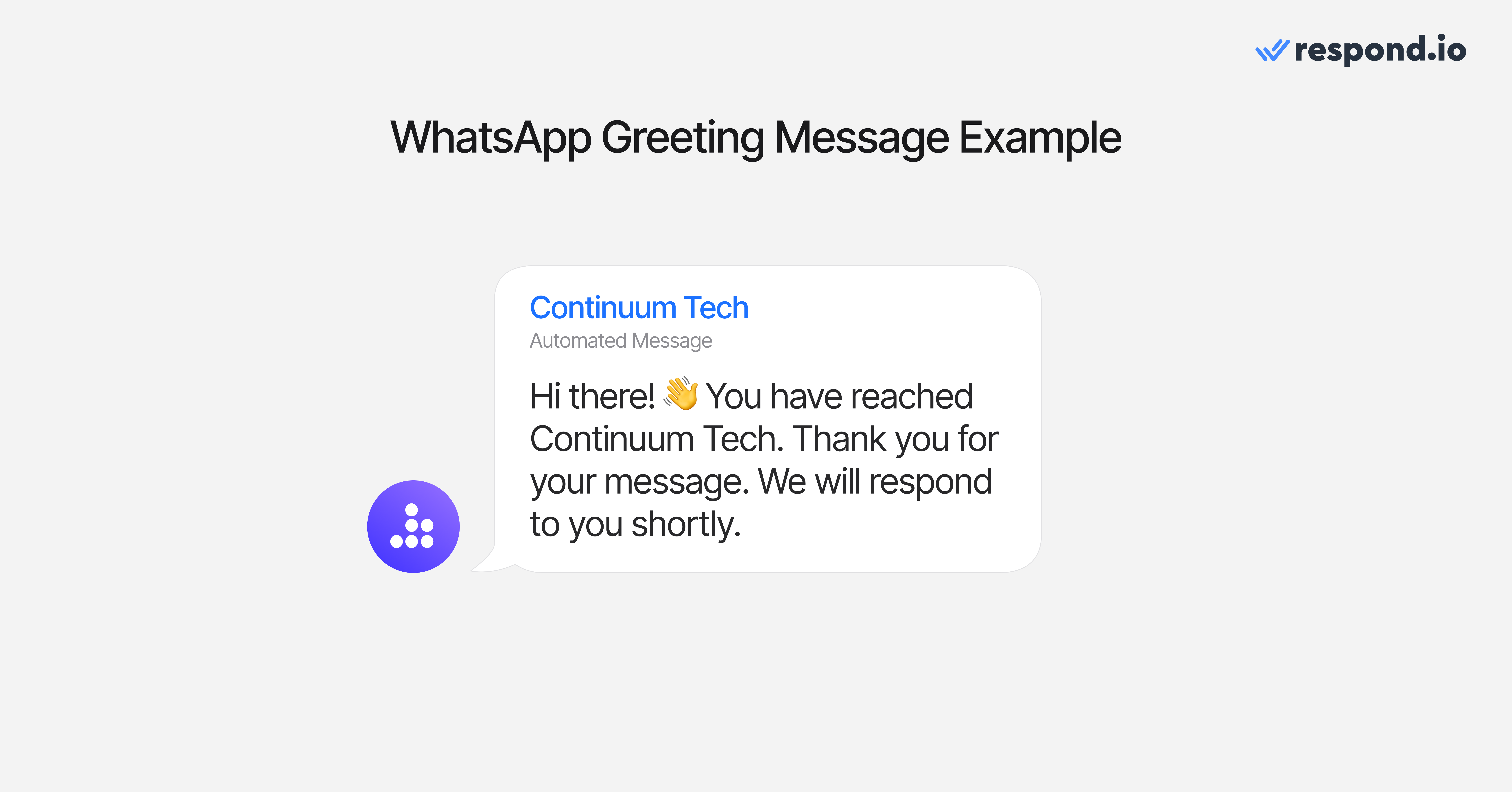
การตั้งค่าข้อความต้อนรับ ใน WhatsApp Business App นั้นง่ายมาก. คุณสามารถปรับข้อความต้อนรับของคุณ ให้เหมาะสมกับวัตถุประสงค์เฉพาะและใช้แนวทางปฏิบัติที่แนะนำ เพื่อให้ได้ประโยชน์สูงสุดจากข้อความ.
หากธุรกิจของคุณไม่สามารถรับประกันการตอบกลับทันทีต่อข้อความขาเข้าทั้งหมด คุณควรมีวิธีการจัดการความคาดหวังเกี่ยวกับเวลารอ.
เมื่อเปิดใช้งาน ข้อความไม่อยู่ของ WhatsApp จะส่งไปยังลูกค้าที่ติดต่อธุรกิจของคุณนอกเวลาทำการหรือเมื่อคุณไม่ว่าง. ใน WhatsApp Business App คุณสามารถกำหนดความพร้อมใช้งานของคุณโดยตั้งค่าตารางเวลา.
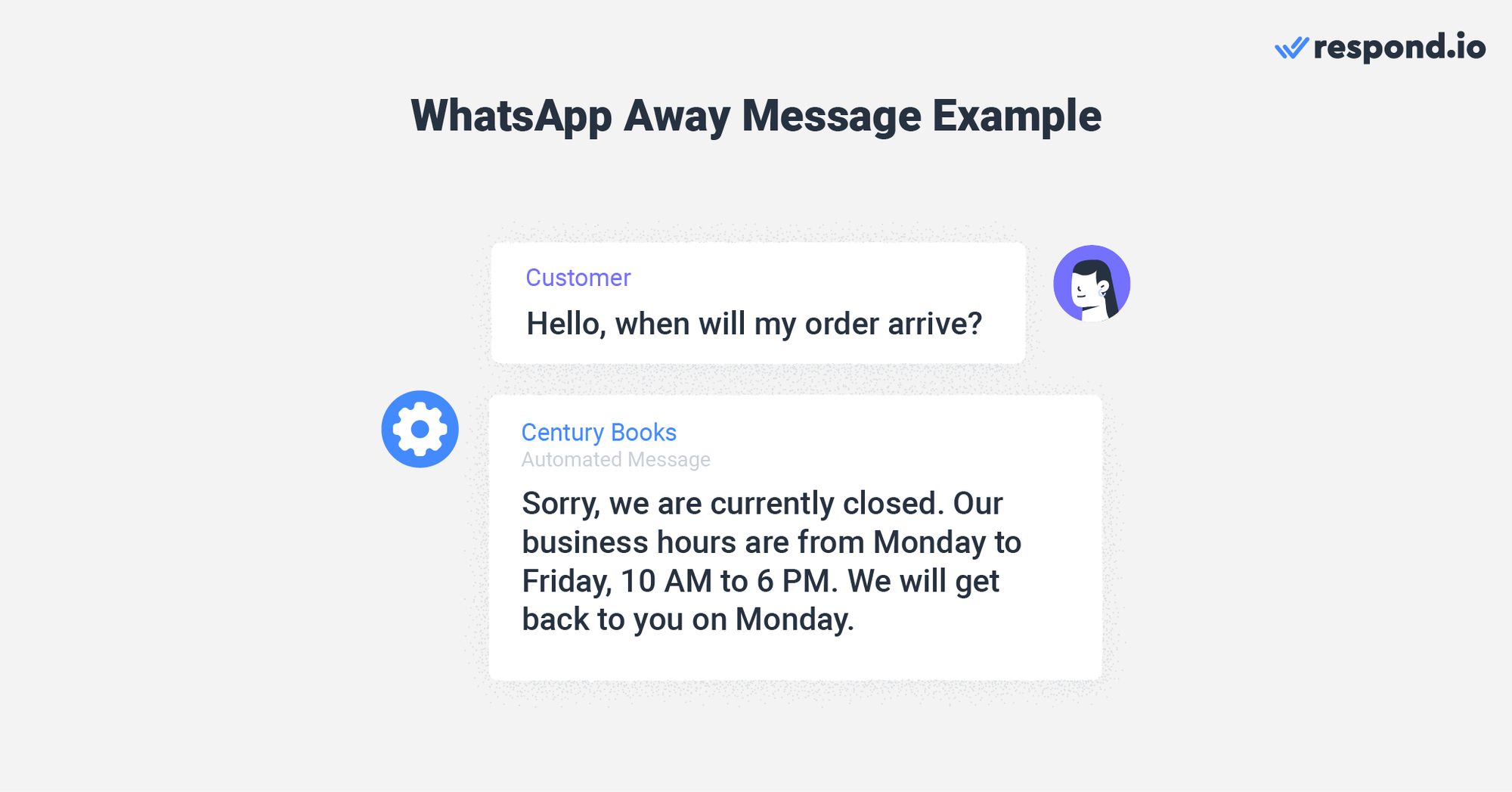
ด้วยการตอบกลับอัตโนมัติ 2 ประเภท WhatsApp Business App จึงเหมาะสำหรับธุรกิจขนาดเล็กเท่านั้น. เรามาทบทวนข้อจำกัดอื่น ๆ ของมันกัน.
การทำงานอัตโนมัติพื้นฐาน
ไม่มีการติดตามประสิทธิภาพการสนทนา
ไม่มีการรวมกับแชทบอท
ไม่มีเมนูแบบโต้ตอบ
ไม่มีการทำงานอัตโนมัติ
ธุรกิจขนาดกลางถึงขนาดใหญ่จะได้รับประโยชน์จากเครื่องมือการทำงานอัตโนมัติของ WhatsApp ที่มีประสิทธิภาพมากขึ้นเช่น WhatsApp Business API.
ธุรกิจที่ต้องการใช้การทำงานอัตโนมัติขั้นสูงของ WhatsApp API กับ respond.io จะต้องปฏิบัติตาม 2 ข้อกำหนด:
ลงทะเบียน สำหรับบัญชี respond.io
เชื่อมต่อ WhatsApp API กับ respond.io
สำหรับผู้ใช้ respond.io โมดูล Workflows เป็นสถานที่ในการสร้างบอทอัตโนมัติของ WhatsApp. โมดูลนี้มีให้บริการในแผนทั้งหมดของ respond.io.
ก่อนอื่น คุณจะต้องมีความรู้พื้นฐานเกี่ยวกับ Workflows ของการสนทนาขาเข้า. หากคุณคุ้นเคยกับสิ่งนี้อยู่แล้ว นี่คือการทำงานอัตโนมัติของ WhatsApp บางประการที่คุณสามารถสร้างจากโมดูลเวิร์กโฟลว์.
ข้อความต้อนรับสำหรับ WhatsApp สามารถสร้างจากศูนย์หรือจากเทมเพลต Workflow เช่น ข้อความต้อนรับ หรือข้อความต้อนรับและขออีเมล.
โดยการเลือกตัวเลือกหลัง ที่อยู่อีเมลของลูกค้า จะถูกบันทึกเป็นContact Fields เพื่อการอ้างอิงในอนาคต. คำขออีเมลจะถูกส่งไปยังลูกค้าที่ ที่อยู่อีเมล ยังไม่ได้ถูกบันทึกไว้ก่อนเพื่อหลีกเลี่ยงการถามคำถามซ้ำซากและทำให้ลูกค้ารู้สึกเหนื่อยหน่าย.
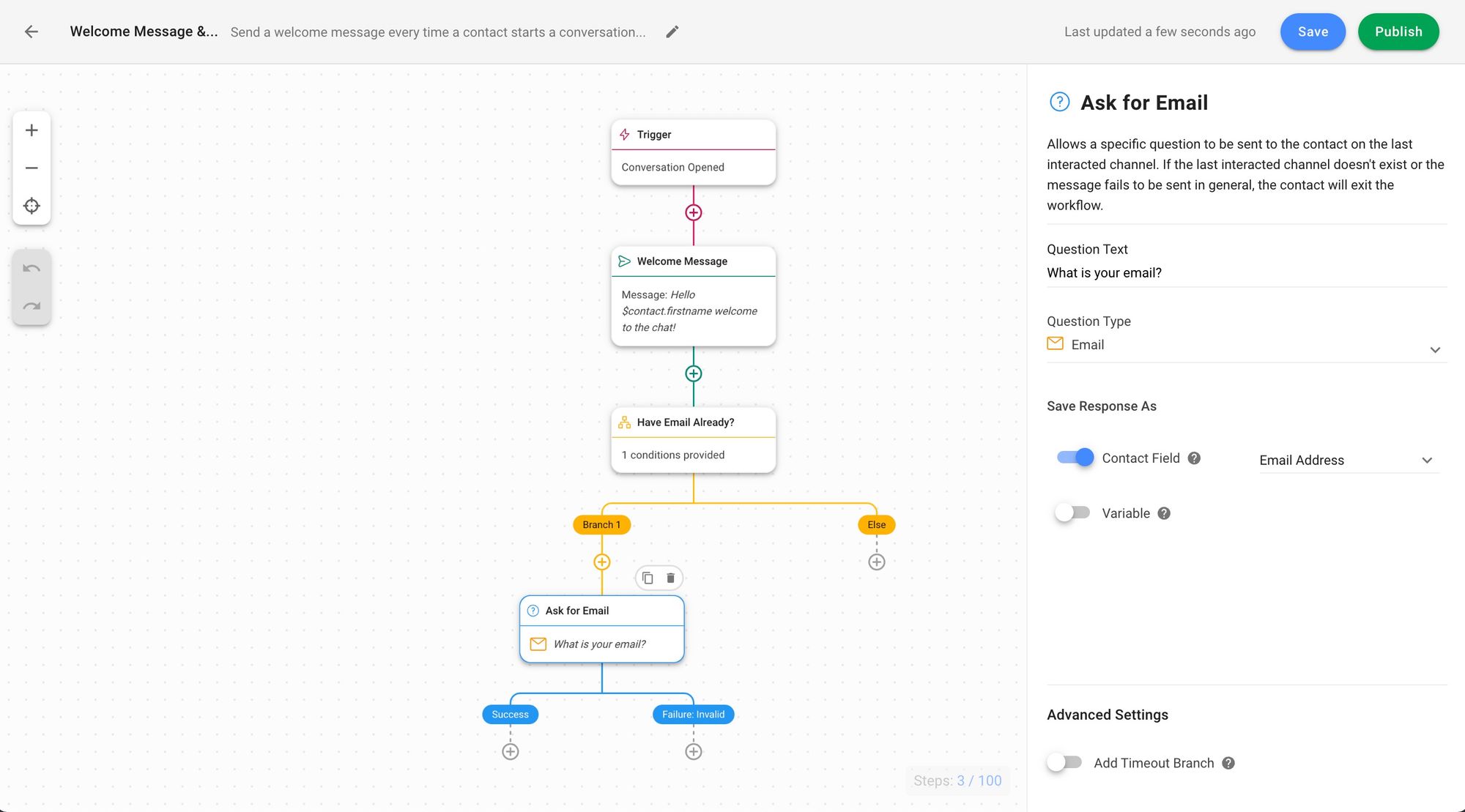
ในการใช้งานข้อความทักทายเฉพาะสำหรับ WhatsApp ให้แทนที่ ช่องทางที่โต้ตอบล่าสุด ใน ขั้นตอนส่งข้อความ ด้วยช่องทาง WhatsApp API ของคุณ
นอกจากนี้คุณยังสามารถปรับแต่งข้อความต้อนรับ WhatsApp โดยใช้ ตัวแปรแบบไดนามิก ตัวอย่างเช่น ใช้ตัวแปรแบบไดนามิก $contact.firstname เพื่อทักทายลูกค้าโดยเฉพาะและสร้างความประทับใจแรกที่เป็นมิตร
การทักทายลูกค้าเป็นสิ่งสำคัญ แต่การจัดการความคาดหวังของพวกเขาก็สำคัญเช่นกัน ถัดไปเราจะแสดงวิธีการใช้เวิร์กโฟลว์เพื่อสร้างข้อความไม่อยู่ของ WhatsApp
ในการสร้างข้อความไม่อยู่ของ WhatsApp ด้วย respond.io สร้างจากศูนย์ หรือเลือก เทมเพลตเวิร์กโฟลว์
เลือกเทมเพลตข้อความไม่อยู่ เพื่อส่งการแจ้งเตือนอัตโนมัติทุกครั้งที่ลูกค้าเริ่มต้นการสนทนา เวิร์กโฟลว์ต้องเปิดและปิดด้วยตนเอง ดังนั้นจึงเหมาะสำหรับธุรกิจที่ให้การสนับสนุนตลอด 24 ชั่วโมง 7 วันและไม่ค่อยไม่อยู่.
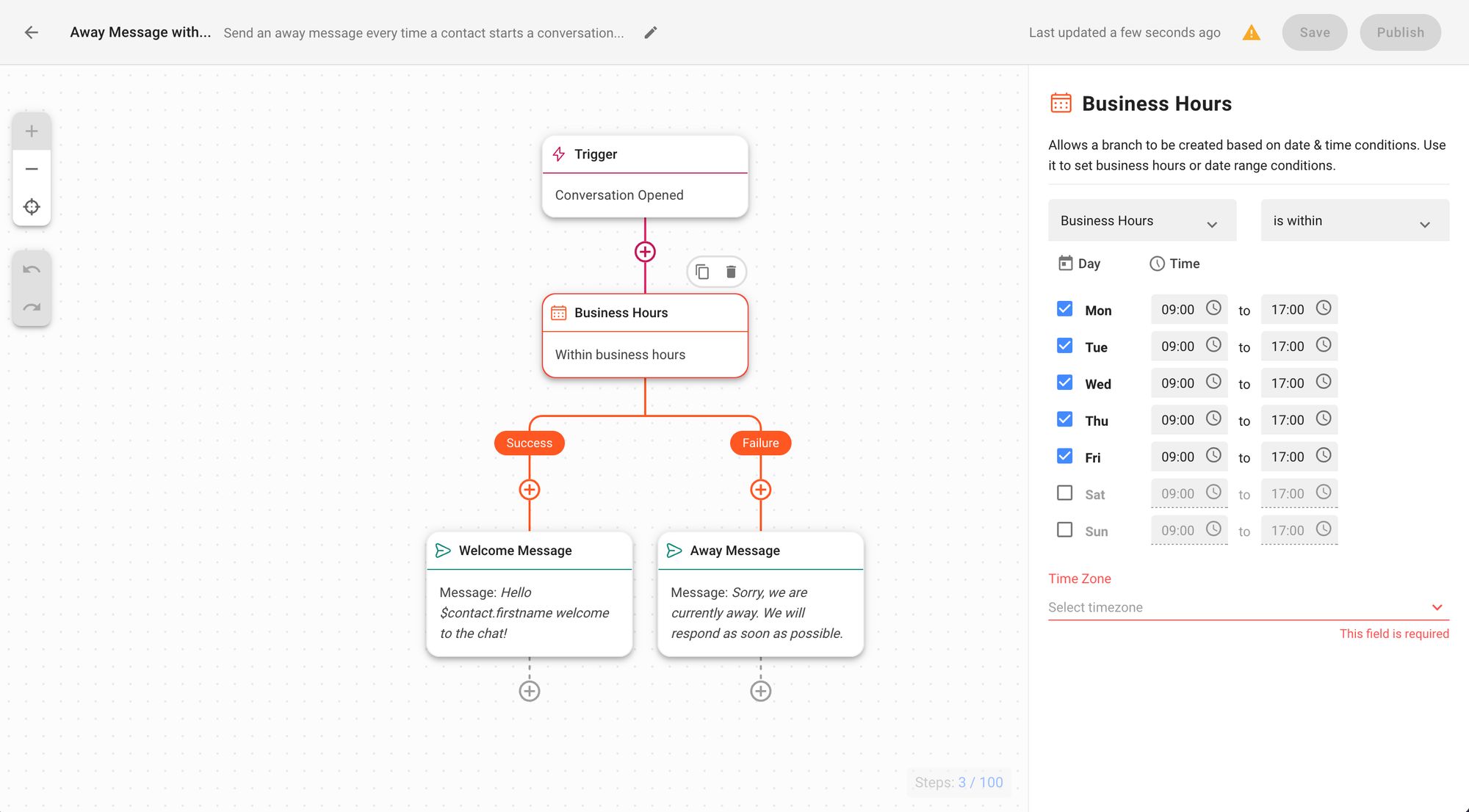
ในทางกลับกัน ใช้เทมเพลตข้อความไม่อยู่ที่มีเวลาทำการ เพื่อส่งข้อความไม่อยู่ของ WhatsApp อัตโนมัตินอกเวลาทำการ คุณเพียงแค่ต้องป้อนเวลาทำการของคุณใน ขั้นตอนวันที่ & เวลา เพื่อกำหนดเมื่อข้อความไม่อยู่จะถูกส่ง.
จนถึงตอนนี้เราอธิบายว่าทักทายลูกค้า WhatsApp ที่เปิดการสนทนากับคุณได้อย่างไร ลองไปอีกขั้นโดยการสร้างบอตถามคำถามเพื่อถามลูกค้าที่คำถามโดยอัตโนมัติ
วิธีที่ง่ายที่สุดในการ สร้างบอตถามคำถามด้วยเวิร์กโฟลว์ของ respond.io คือการใช้ ขั้นตอนถามคำถาม ขั้นตอนนี้มีหลายหมวดหมู่ย่อยเพื่อตั้งคำถามประเภทต่าง ๆ เช่น คำถามที่มีตัวเลือกตอบหลายตัว ตัวอักษร หรือคะแนนจาก 1-5 เป็นคำตอบ
มีหลายเหตุผลที่ธุรกิจอาจถามคำถามลูกค้าเมื่อพวกเขาติดต่อผ่าน WhatsApp บางธุรกิจชอบมีวิธีการติดต่อสำรองเพื่อเข้าถึงลูกค้าเมื่อการสนทนาสิ้นสุดลงดังนั้นพวกเขาอาจขอที่อยู่อีเมล
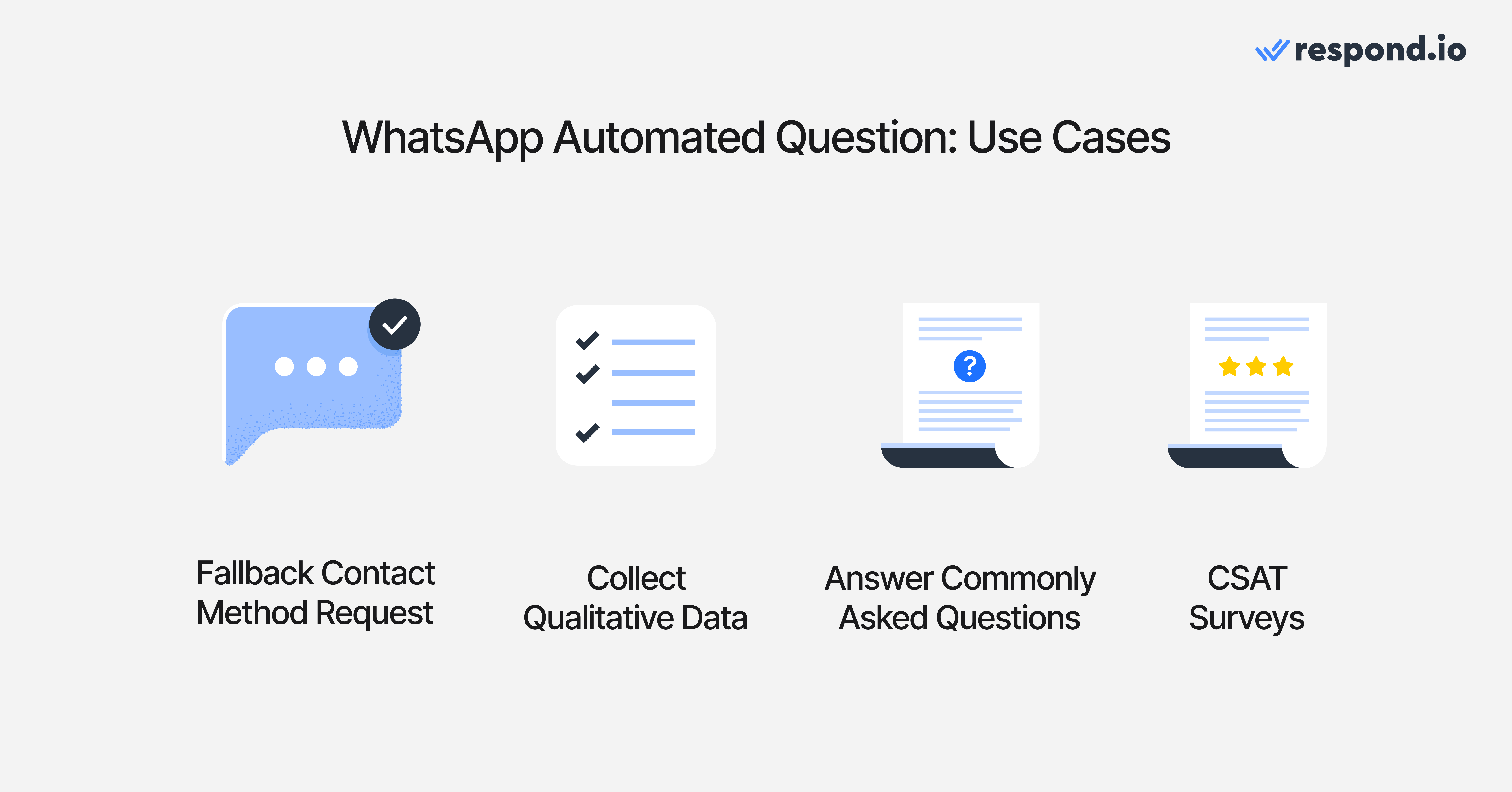
แม้ว่าคำถามเปิดจะจัดหมวดหมู่และนับง่าย แต่ธุรกิจอาจใช้คำถามเหล่านั้นเพื่อรวบรวมข้อมูลเชิงคุณภาพและข้อมูลเชิงลึกเกี่ยวกับพฤติกรรมของลูกค้า ตัวอย่างเช่น ธุรกิจอาจถามลูกค้าสาเหตุหลักที่คุณเลือกบริการของเราคืออะไร?
เพื่อแก้ไขข้อซักถามของลูกค้าที่เกิดขึ้นเป็นประจำในทันที ธุรกิจสามารถสร้างคำถาม FAQ อัตโนมัติ โดยใช้ประเภทคำถามแบบเลือกหลายตัวเลือก สิ่งนี้สามารถให้คำตอบทันทีสำหรับข้อซักถามทั่วไปเกี่ยวกับราคา เงื่อนไขในการให้บริการ หรือค่าขนส่ง
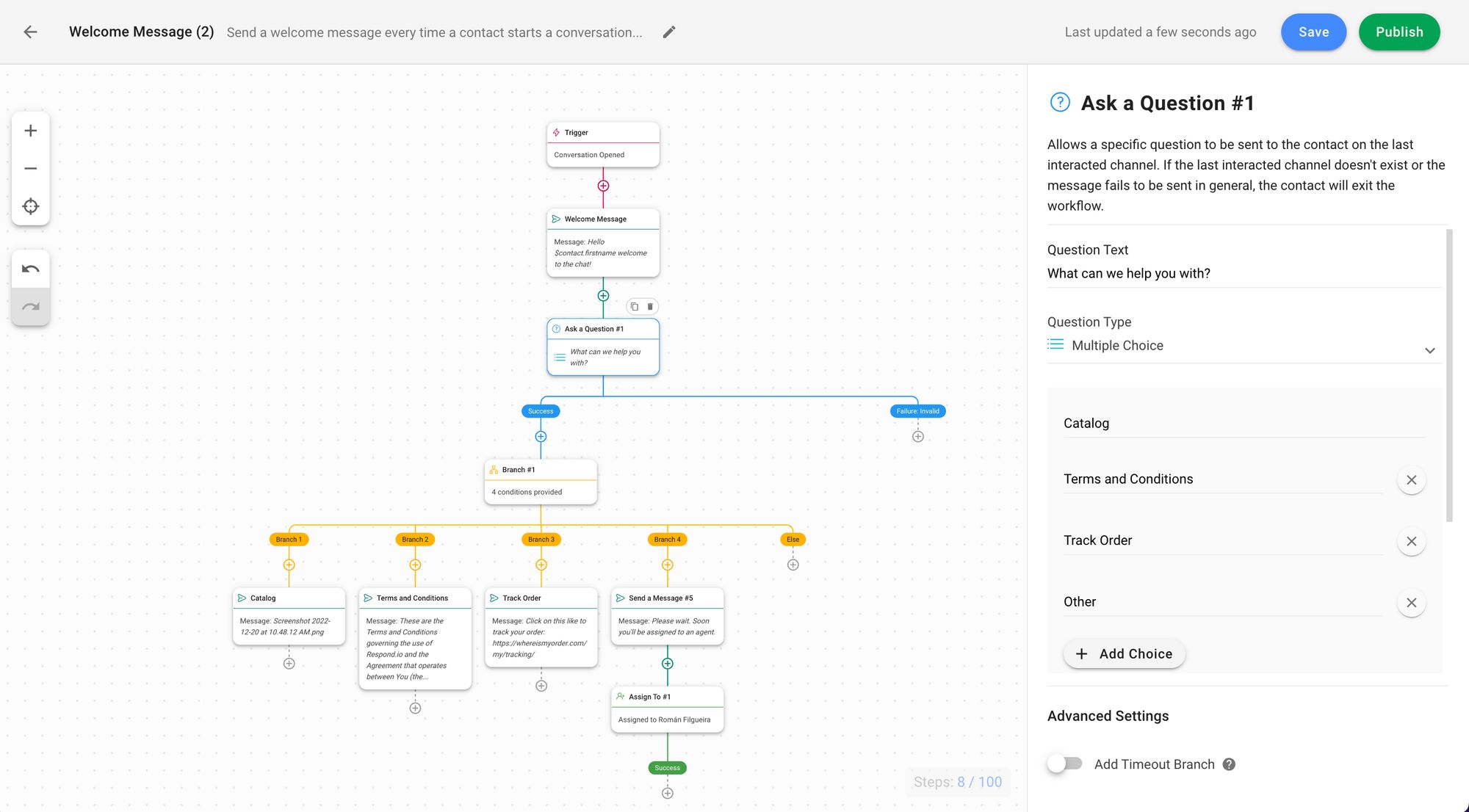
การสำรวจ CSAT ถูกใช้เพื่อวัดระดับความพึงพอใจที่ลูกค้าได้รับหลังจากการโต้ตอบเฉพาะเจาะจงกับบริษัท คุณสามารถสร้างเวิร์กโฟลว์แบบง่ายๆ เพื่อ สร้างการสำรวจ CSAT และบันทึกคำตอบลงใน Google Sheets หรือ คลังข้อมูล
สุดท้าย ขั้นตอนการตั้งคำถามสามารถใช้เพื่อส่งลูกค้าไปยังทีมที่เหมาะสมและมอบหมายลูกค้าให้กับตัวแทนที่มีอยู่โดยอัตโนมัติตามคำตอบที่ให้มา มาดูกันว่าจะทำอย่างไร
องค์กรที่มีการสนทนาหลายครั้งในแต่ละวันด้วย บัญชีผู้ใช้หลายคนใน WhatsApp ไม่สามารถพึ่งพาตัวแทนให้เลือกและแก้ไขปัญหาด้วยตนเองได้ พวกเขาต้องการโซลูชันทางธุรกิจเพื่อกำหนดเส้นทางการสนทนาและกำหนดให้กับตัวแทนโดยอัตโนมัติ
ด้วย respond.io คุณสามารถสร้าง เวิร์กโฟลว์การกำหนดเส้นทาง ของคุณเองจากศูนย์หรือ เลือกเทมเพลตเวิร์กโฟลว์ เช่น การกำหนดเส้นทางทีมหลายกลุ่ม: กะ ซึ่งเหมาะสำหรับบริษัทที่มีทีมงานที่ทำงานตลอดเวลาที่ต้องการมอบหมายการสนทนาตามกะ.
การกำหนดเส้นทางหลายทีม: การเลือกหลายรายการตามผู้ติดต่อ เป็นเทมเพลตเวิร์กโฟลว์ที่สร้างขึ้นสำหรับธุรกิจที่ต้องการ กำหนดเส้นทางลูกค้าตามฟังก์ชันของทีม เช่น การสอบถามการขายหรือคำขอการสนับสนุน
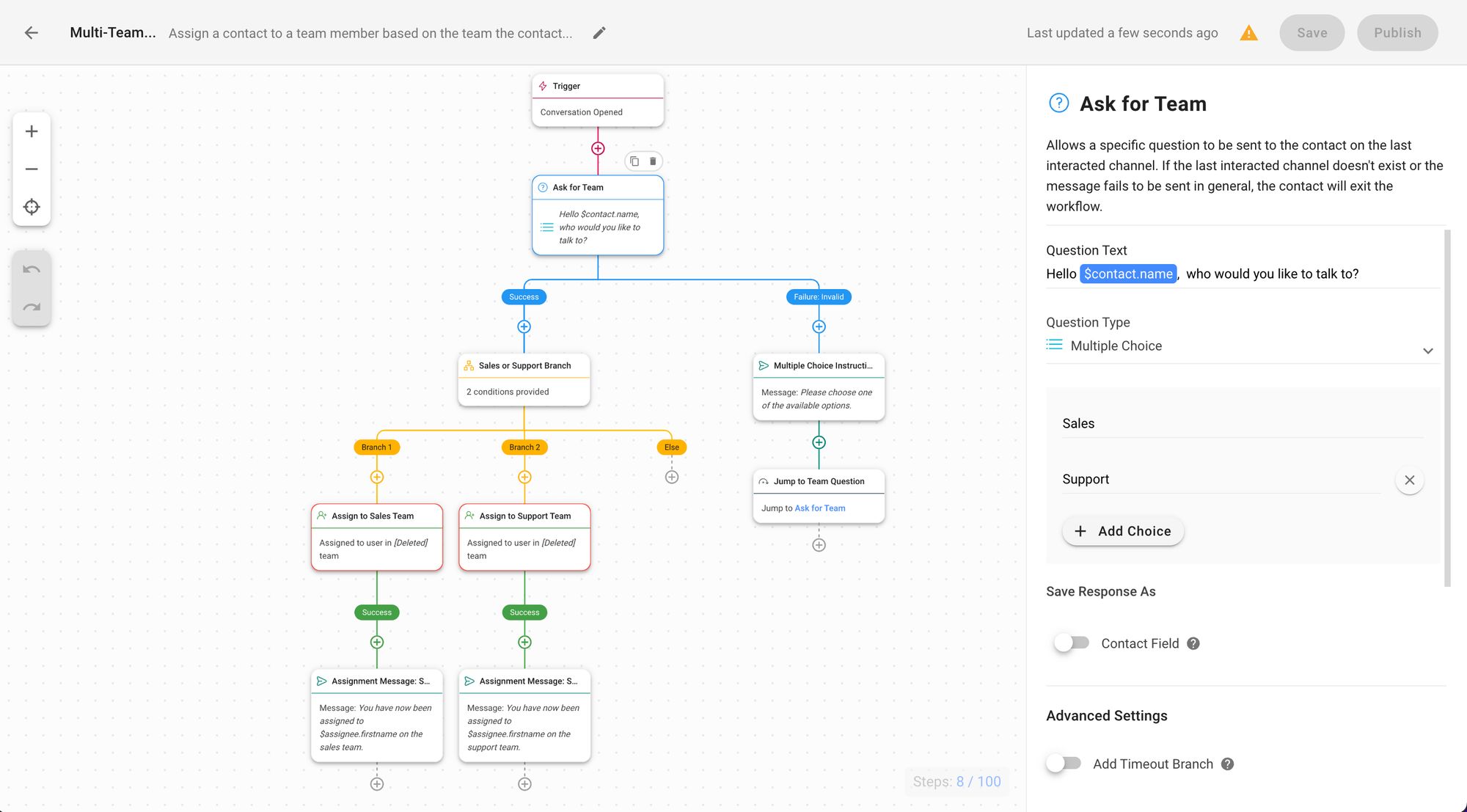
ในเรื่องการมอบหมายตัวแทนโดยอัตโนมัติ เทมเพลตเวิร์กโฟลว์จะช่วยให้คุณเริ่มได้ด้วยสองลอจิก ที่เลือกจาก: การหมุนเวียนเพื่อมอบหมายการสนทนาอย่างเท่าเทียมกันระหว่างตัวแทนหรือจากการติดต่อที่เปิดน้อยที่สุดเพื่อบริการที่รวดเร็วยิ่งขึ้นโดยตัวแทน.
ด้วย ขั้นตอน HTTP Request ของ respond.io ในเวิร์กโฟลว์ ธุรกิจสามารถดำเนินการกลับไปยังแอปพลิเคชันบุคคลที่สามเพื่อถ่ายโอนข้อมูลระหว่างกันและ respond.io นี่คือกรณีการใช้งานทั่วไปบางประการ:
เชื่อมต่อ WhatsApp CRM กับ respond.io
ปรับคุณภาพลูกค้า บนเครื่องมือการเสริมข้อมูล
สร้างดีล ใน CRM การขายหรือตั๋วใน CRM การสนับสนุน
บันทึกผล CSAT ในคลังข้อมูลหรือ Google Sheets
และยังมีข้อเสนอพิเศษ เชื่อมต่อ respond.io กับ Zapier จะทำให้คุณเข้าถึงการบูรณาการแอปมากกว่า 5,000 แอป เครื่องมือวิเคราะห์ แอปปฏิทิน ฐานข้อมูล… คุณตั้งชื่อมัน และเช่นเดียวกับเวิร์กโฟลว์ของ respond.io การทำงานอัตโนมัติของ Zapier ไม่ต้องการโค้ด.
ธุรกิจด้านการดูแลสุขภาพ สามารถพัฒนาให้ดีขึ้นได้อย่างมากด้วยการทำงานอัตโนมัติของ WhatsApp ห้องรอแบบเสมือนทำให้ผู้ป่วยได้รับข้อมูลและลดการแออัดทางกายภาพ
การเก็บข้อมูลก่อนการปรึกษาโดยอัตโนมัติทำให้มั่นใจได้ว่าผู้ให้บริการด้านการดูแลสุขภาพเตรียมพร้อมที่จะทำงานซึ่งช่วยเพิ่มประสิทธิภาพ กรณีง่ายๆ สามารถแก้ไขได้อย่างรวดเร็วช่วยประหยัดเวลาให้กับปัญหาที่ซับซ้อนมากขึ้น กรณีที่ซับซ้อนสามารถเพิ่มไปยังผู้เชี่ยวชาญได้อย่างราบรื่นทำให้แน่ใจว่าผู้ป่วยได้รับการดูแลที่ดีที่สุด
นอกจากนี้ การจัดการเส้นทางผู้ป่วยและการมอบหมายตัวแทนโดยอัตโนมัติช่วยให้สามารถติดตามและติดตามผลได้อย่างมีประสิทธิภาพเพื่อให้มั่นใจว่ามีการปฏิบัติตามแผนการรักษาและนัดหมาย
การทำงานอัตโนมัติของ WhatsApp สามารถเพิ่มประสิทธิภาพของสถาบันการศึกษาได้อย่างมาก การตอบกลับที่รวดเร็วต่อลูกค้าที่รอคอยในช่วงเวลาเข้าศึกษาช่วยป้องกันไม่ให้ลูกค้าหายไปเนื่องจากความล่าช้า
การใช้ Respond AI ซึ่งเป็นแชทบอทชั้นนำสำหรับการศึกษา สถาบันสามารถให้การตอบกลับทันทีต่อข้อซักถามและเก็บข้อมูลตลอด 24/7 ก่อนที่ตัวแทนมนุษย์จะเข้า การทำงานอัตโนมัติยังช่วยกรองสแปมช่วยให้ตัวแทนสามารถมุ่งเน้นไปที่การโต้ตอบที่มีความหมายได้
การทำให้กระบวนการจาก การสมัครเข้าร่วมกิจกรรมไปยังการลงทะเบียน เป็นเรื่องที่ง่ายดายด้วยการรวมเข้ากับระบบการจัดการนักเรียน CRM และ ERP นอกจากนี้ การส่งรายละเอียดกิจกรรม การแจ้งเตือน และการสำรวจความพึงพอใจของนักเรียนโดยอัตโนมัติช่วยให้มั่นใจว่าการสื่อสารมีประสิทธิภาพและการพัฒนาอย่างต่อเนื่อง
นี่คือวิธีที่การทำงานอัตโนมัติของ WhatsApp สามารถเพิ่มประสิทธิภาพการดำเนินงานของการค้าปลีกได้อย่างมาก สำหรับเริ่มต้น การรวม ERP หรือ CRM การขายของคุณจะช่วยให้สามารถเรียกดูข้อมูลแบบเรียลไทม์และสร้างดีลระหว่างการสนทนา
การทำงานอัตโนมัติของกระบวนการขาย ตั้งแต่ การตรวจสอบคุณภาพลูกค้าไปจนถึงการฟื้นฟูตะกร้าที่ถูกทิ้ง ช่วยเพิ่มประสิทธิภาพ ตัวอย่างเช่น การสร้างเส้นทาง VIP จะให้บริการที่มุ่งเน้นไปที่ลูกค้าที่มีมูลค่าสูงและเพิ่มความพึงพอใจให้กับลูกค้า นอกจากนี้ การให้การสนับสนุน 24/7 ผ่านคำถามที่พบบ่อยอัตโนมัติและการเข้าถึงตัวแทนมนุษย์ทำให้มั่นใจได้ว่ามีการช่วยเหลืออย่างต่อเนื่อง
การรวม CRM การสนับสนุนของคุณจะช่วยสร้างตั๋วในระหว่างการสนทนา นอกจากนี้ การทำงานของกระบวนการเช่นการเพิ่มการสนับสนุนและการส่งการสำรวจ NPS หรือ CSAT จะทำให้การดำเนินงานราบรื่นและปรับปรุงประสบการณ์ของลูกค้าโดยรวม
ธุรกิจในอุตสาหกรรมยานยนต์สามารถใช้การทำงานอัตโนมัติของ WhatsApp เพื่อตอบกลับคำถามการขายได้ทันที เมื่อผู้ซื้อกำลังซื้อรถ พวกเขามักจะมีคำถามมากมาย การตอบกลับอย่างรวดเร็วและละเอียดสามารถสร้างความแตกต่างในการตัดสินใจของพวกเขาในการเข้ามาทดสอบขับรถ
หากลูกค้าหมายถึงการพูดคุยกับผู้ขายและเพียงแค่ต้องการมาที่โชว์รูม คุณสามารถทำการจองนัดหมายโดยอัตโนมัติด้วย ลูกค้าสามารถจองช่วงเวลาทั้งที่ไม่ต้องรอ และนี่ยังช่วยให้ตัวแทนขายมีเวลาว่างเพื่อโฟกัสลูกค้าที่พร้อมจะซื้อ.
การส่งข้อมูลประชาสัมพันธ์ไปยังลูกค้าเก่า ช่วยทำให้ธุรกิจของคุณนึกถึง. ตัวอย่างเช่น หนึ่งในลูกค้าของเราในอุตสาหกรรมยานยนต์ที่กลับมายังผู้ซื้อที่เคยซื้อเมื่อ 5 ปีที่แล้ว. นี่เป็นกลยุทธ์ที่มีประสิทธิภาพในระยะยาว เนื่องจากผู้คนส่วนใหญ่จะไม่ซื้อรถทุกปี แต่การเตือนส่วนบุคคลอาจทำให้ธุรกิจของคุณเป็นตัวเลือกแรก.
ผู้ให้บริการด้านบริการมืออาชีพจำนวนมากใช้ WhatsApp เพื่อลดขั้นตอนการจองให้เป็นอัตโนมัติ. ไม่ว่าจะเป็นงานทำความสะอาดหรือการถ่ายภาพ การให้ลูกค้าจองผ่าน WhatsApp ช่วยให้กระบวนการจัดตารางดำเนินไปอย่างราบรื่น.
ส่งการแจ้งเตือนอัตโนมัติและแบ่งกลุ่มลูกค้าตามบริการที่เคยใช้ เพื่อที่จะส่งข้อมูลการส่งเสริมการขายล่าสุดและสร้างลูกค้าประจำ.
นอกจากนี้ยังเป็นประโยชน์ในการส่งแบบสำรวจ CSAT หลังจากบริการที่เสร็จสมบูรณ์ เพื่อตรวจสอบขอบเขตที่ต้องปรับปรุงและรักษาลูกค้าให้กลับมา.
บริษัทท่องเที่ยวสามารถใช้ WhatsApp ในการทำงานอัตโนมัติ เพื่อตอบคำถามทั่วไปเกี่ยวกับนโยบายและแพ็คเกจ เพื่อให้ลูกค้าได้รับคำตอบทันที.
เมื่อผู้มีโอกาสเป็นลูกค้าพร้อมจะแจ้งขอจองแพ็คเกจหรือมีคำถามเฉพาะที่ FAQ ไม่สามารถตอบได้ สามารถตั้งค่าอัตโนมัติเพื่อพวกเขาไปยังตัวแทน. ตัวอย่างเช่น บางธุรกิจสามารถส่งลูกค้าไปยังตัวแทนที่ว่างถัดไป ขณะที่บางธุรกิจอาจมอบหมายให้กับตัวแทนที่มีความเชี่ยวชาญในจุดหมายปลายทาง.
เมื่อผู้มีโอกาสเป็นลูกค้าได้กลายเป็นลูกค้า คุณสามารถ กำหนดเวลาการส่งข้อความ WhatsApp เพื่อให้ข้อมูลอัปเดตเกี่ยวกับแผนการเดินทาง.
พร้อมที่จะตั้งค่าการทำงานอัตโนมัติของ WhatsApp หรือยัง? หากคุณเป็นธุรกิจเล็กหรือไมโครที่ใช้แอป WhatsApp Business สำหรับการสื่อสารกับลูกค้า ฟีเจอร์การทำงานอัตโนมัติในแอปฟรีอาจเพียงพอ
อย่างไรก็ตาม สำหรับกรณีการใช้งานส่วนใหญ่ที่เราแสดงให้เห็น ธุรกิจขนาดกลางจนถึงขนาดใหญ่จึงต้องเชื่อมต่อ WhatsApp API กับ แพลตฟอร์มการส่งข้อความหลายช่องทาง ที่มีเครื่องมือการสร้างเวิร์กโฟลว์ที่ทรงพลังเพื่อจัดระเบียบงานที่ใช้เวลานานและจัดการข้อความจำนวนมากอย่างมีประสิทธิภาพ.
เพื่อเริ่มใช้ประโยชน์จากคุณค่าของการทำงานอัตโนมัติของ WhatsApp ทดลองใช้ respond.io ฟรี หรือ ติดต่อเราสำหรับ เดโมที่ปรับแต่ง.
เปลี่ยนบทสนทนาให้กลายเป็นลูกค้าด้วย WhatsApp API อย่างเป็นทางการของ respond.io ✨
จัดการการโทรและแชท WhatsApp ในที่เดียว!
เปิดแอป WhatsApp Business
แตะตัวเลือกเพิ่มเติม > เครื่องมือธุรกิจ > ข้อความไม่อยู่
เปิดการส่งข้อความไม่อยู่
ภายใต้ข้อความไม่อยู่ ให้แตะข้อความเพื่อแก้ไข จากนั้นแตะตกลง
แตะกำหนดเวลาเพื่อนัดหมายข้อความไม่อยู่ของคุณ ...
แตะผู้รับเพื่อกำหนดว่าผู้ควรได้รับข้อความไม่อยู่ของคุณ ...
แตะบันทึก
ใช่ แม้ว่าไม่สามารถทำได้ด้วยแอป WhatsApp Business แต่คุณสามารถอัตโนมัติ ส่งข้อความจำนวนมากของ WhatsApp ด้วย WhatsApp Business API — ที่รู้จักกันในชื่อแพลตฟอร์ม WhatsApp Business
เลือกแพลตฟอร์ม CRM ที่เหมาะสม ตรวจสอบให้แน่ใจว่าแพลตฟอร์ม CRM ของคุณรองรับการรวม WhatsApp
ตั้งค่า WhatsApp Business API
กำหนดเวิร์กโฟลว์การสื่อสาร
ฝึกอบรมทีมของคุณ
ติดตามและวิเคราะห์ประสิทธิภาพ
แชทบอทของ WhatsApp สามารถแก้ไขคำถามของลูกค้าได้รวดเร็วและมีประสิทธิภาพมากกว่าตัวแทนมนุษย์อย่างแน่นอน อย่างไรก็ตาม คำถามที่ซับซ้าบางอย่างต้องการความละเอียดอ่อนและการคิดอย่างมีวิจารณญาณ นั่นคือเหตุผลที่คุณควรเสนอทางเลื่อนระดับไปยังตัวแทนมนุษย์ให้กับลูกค้าเสมอ
ในช่วงไม่กี่ปีที่ผ่านมา โซลูชันบอทและระบบอัตโนมัติสำหรับ WhatsApp ได้เพิ่มขึ้นอย่างมาก จากตัวเลือกมากมาย เราขอแนะนำให้ใช้ respond.io ออกแบบและตั้งราคาเพื่อธุรกิจทุกรูปแบบ มีความสามารถในการทำงานอัตโนมัติของ WhatsApp ขั้นสูงและ มากกว่านั้น!
เพื่อเริ่มต้นกับ WhatsApp Business API คุณสามารถดูคู่มือรวมทุกอย่างของเรา: วิธีการขอรับ WhatsApp API
คุณคิดว่าการอ่านนี้มีความน่าสนใจหรือไม่? หากเป็นเช่นนั้น เราขอแนะนำให้คุณดูบทความต่อไปนี้
Román Filgueira ผู้สำเร็จการศึกษาจากมหาวิทยาลัย Vigo และสำเร็จการศึกษาระดับปริญญาตรีสาขาภาษาต่างประเทศ เข้าร่วมทีม respond.io ในตำแหน่งนักเขียนเนื้อหาในปี 2021. Román ให้ข้อมูลเชิงลึกจากผู้เชี่ยวชาญเกี่ยวกับแนวทางปฏิบัติที่ดีที่สุดในการใช้แอปการส่งข้อความเพื่อขับเคลื่อนการเติบโตทางธุรกิจ.

ธุรกิจไม่สามารถส่งข้อความ WhatsApp ได้หลังจาก 24 ชั่วโมง เว้นแต่จะใช้เทมเพลตข้อความ WhatsApp เรียนรู้วิธีการจัดรูปแบบและส่งข้อความเทมเพลตพร้อมตัวอย่าง